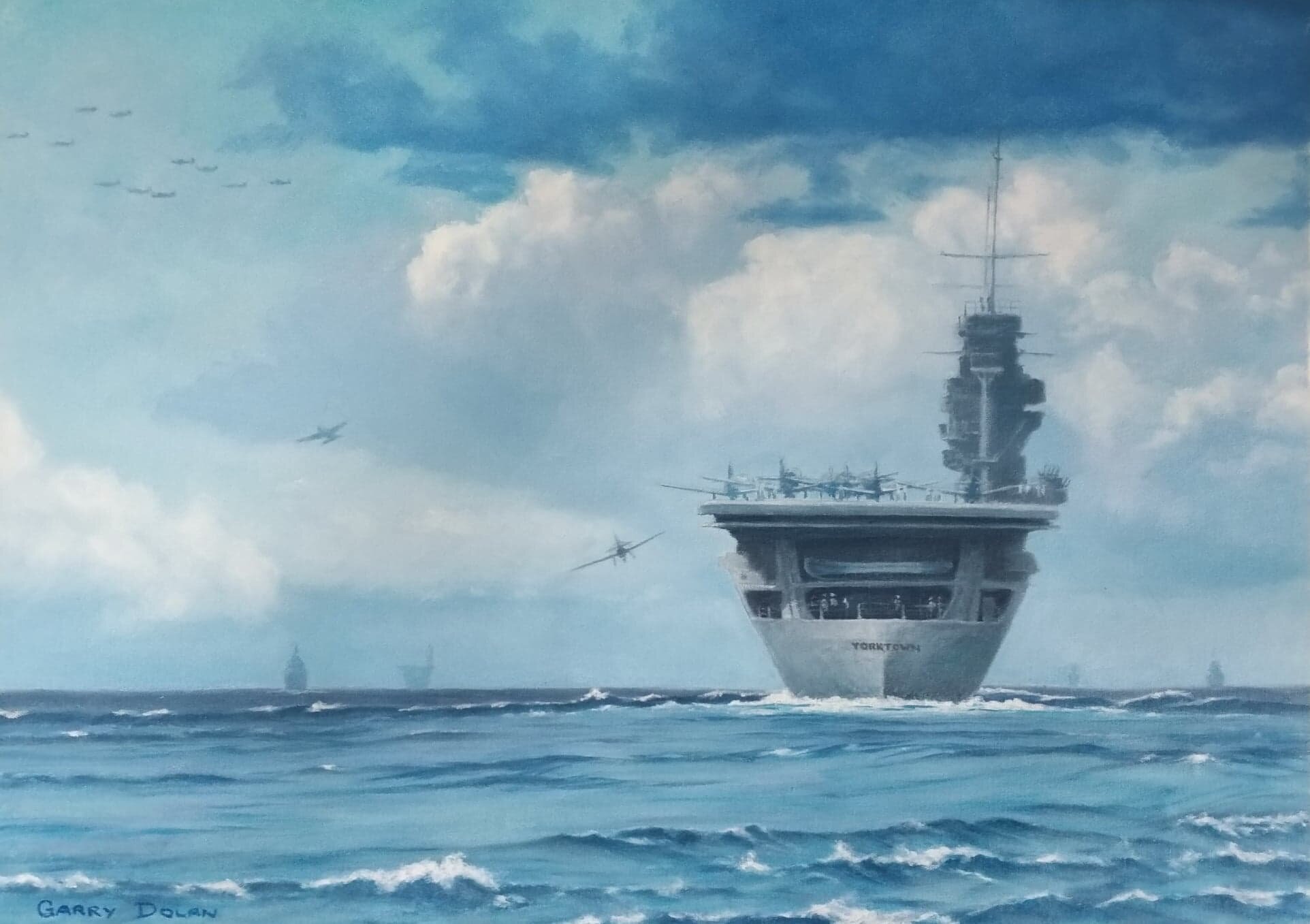
Pentagon Exhibition
‘The Kangaroo and the Eagle, Friends and Allies 1908 to 2019’
exhibited at The pentagon through 2021

'Dawn of a new era' 70cm x 50cm This work depicts the launching of aircraft from the USS Yorktown and in the distance, the USS Lexington to start the Battle of the Coral Sea. This battle was significant for many reasons. It was significant in that it was the first pure carrier-versus-carrier battle in history as neither surface fleet sighted the other effectively ushering in a new era in naval warfare. Though a draw, it was an important turning point in the war in the Pacific because, for the first time, the Allies had stopped the Japanese advance. The Battle of the Coral Sea was significant to Australia in that Japanese occupation of Port Moresby would not only cut off the eastern sea approaches to Darwin but provide the Imperial Japanese Navy with a secure operating base on Australia's northern doorstep. The relentless advance of the Japanese forces created a feeling of depression in the general populace of Australia and a general expectation that the Japanese would invade at any moment. With the benefit of hindsight, Australians today may scoff at the fears of a Japanese invasion during 1942 the fact is that for many Australians during the 1940s that fear was very real. In the mind of the average man-on-the-street, the American and Australian Navies had saved Australia.
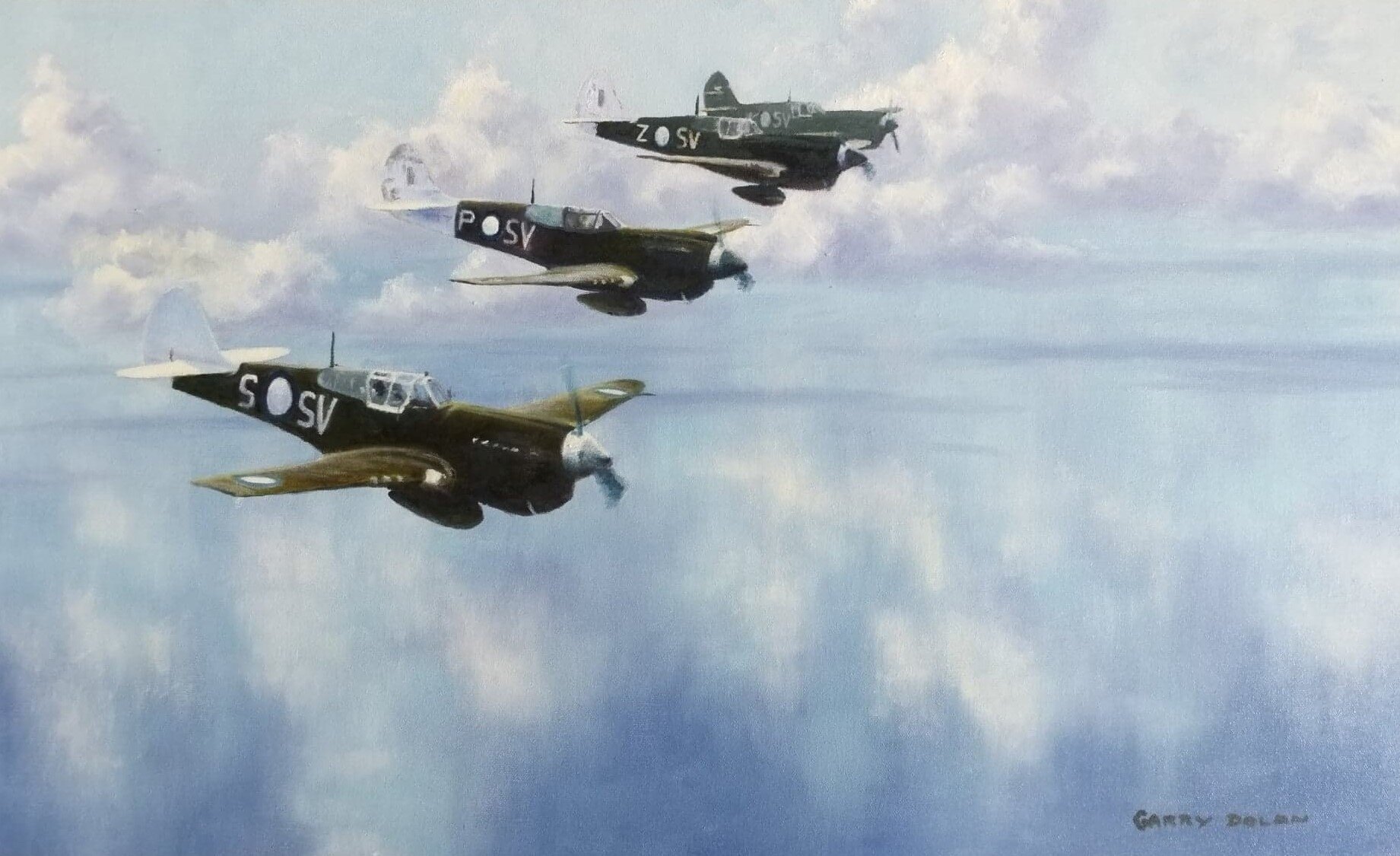
'American Machines, Aussie Pilots', 75cm x 45cm Based at Noemfoor from mid-October 1944, the Kittyhawks of the RAAF’s No. 76 Squadron as part of No. 10 Group attacked Japanese positions in western New Guinea and the eastern islands of the Netherlands East Indies to support the United States landing at Leyte in the Philippines.
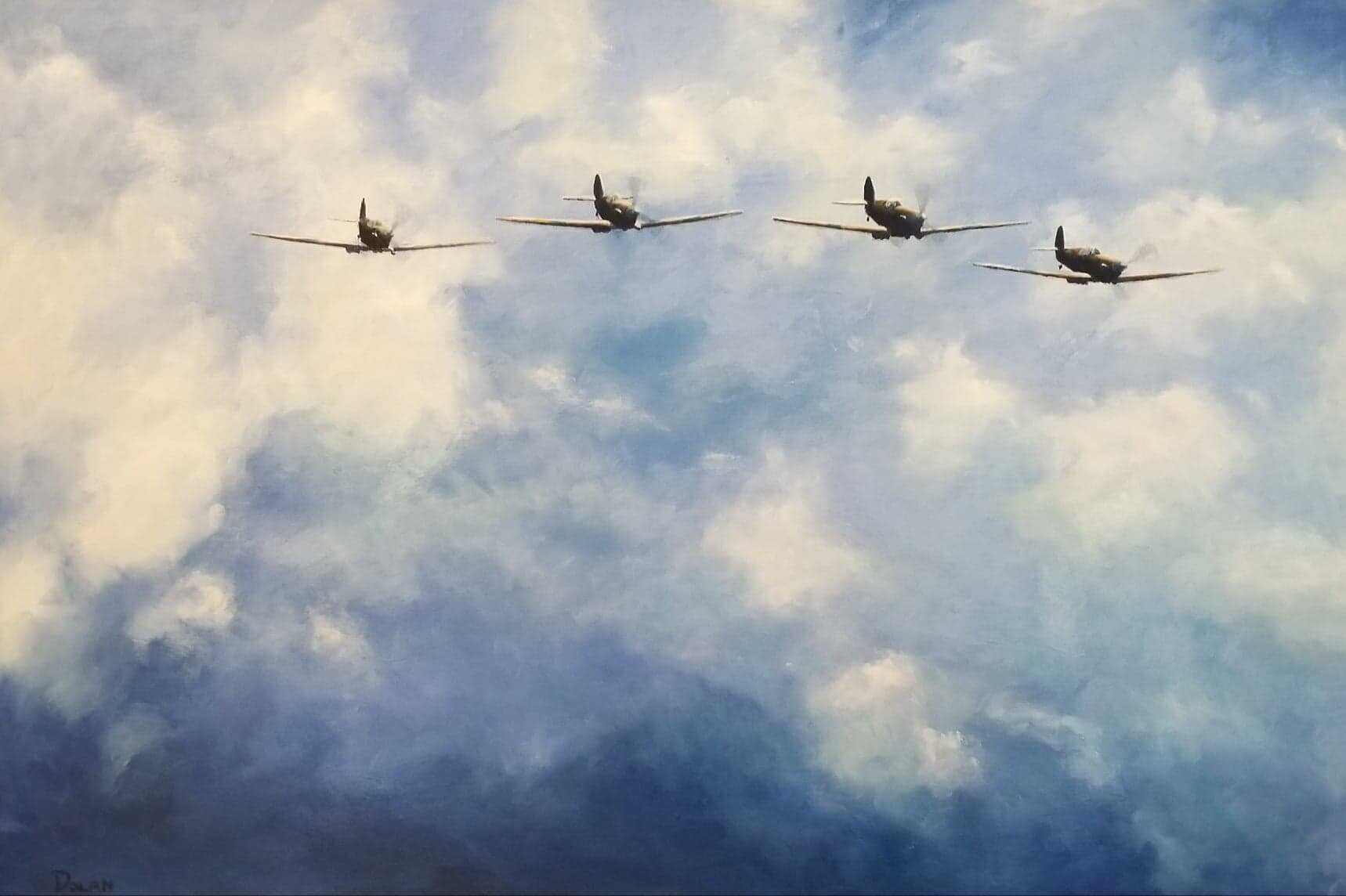
'From the skies of the Pacific pours down a deathly hail', 70cm x 50cm In early 1944 No 79 Squadron as part of No. 73 Wing was selected to support the US Army's Admiralty Islands campaign. On 29 February ,the United States 1st Cavalry Division began to land on the islands and the 73 Wing moved to Momote Airstrip on Los Negros Island in March 1944 to provide greater support. No. 79 Squadron, with 24 aircraft flew ground attack sorties in support of US troops until Japanese resistance ceased.
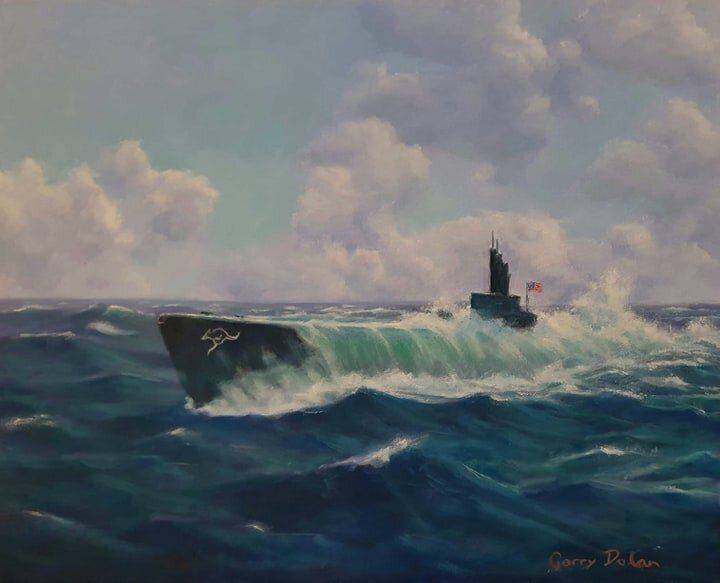
'The Kangaroo Express' 40cm x 50cm This painting is a tribute to two men and an American submarine that became a favourite of the people of Brisbane. During an encounter on 7 February 1943 the USS Growler was rammed by a Japanese patrol boat. With machine gun fire raking the submarine at point-blank range, grievously wounded Commander Gilmore still on the bridge and unable to get below realized that he was jeopardizing his boat's escape. He ordered, "Take her down!". By saving his command at the cost of his own life, Gilmore became the first of seven World War II submariners to earn the Medal of Honor. The Growler returned to Brisbane for extensive repairs. Following the refit, the submarine was nicknamed the Kangaroo Express, as the refabricated bow had two nickel kangaroos as decorations. The Growler became a favourite amongst the Brisbane population with the commander often seen wearing an Australian Army slouch hat. McClelland Barclay (1891 – 18 July 1943) was an accomplished American illustrator and artist that joined the Navy at the outbreak of war. As a Naval Reservist he was employed illustrating recruitment posters, many would become some of the most recognizable recruiting images of World War II. As a Lt. Commander, based in Brisbane he created a painting of the USS Growler before being lost when the USS LST-342 he was aboard was torpedoed in the Solomon Islands. On board, sketching and taking photographs at the time, Barclay's body was not recovered. McClelland Barclay’s painting of the USS Growler was presented to the U.S. Navy Submarine Force Museum in Groton, Connecticut after the War where it remains on display today.
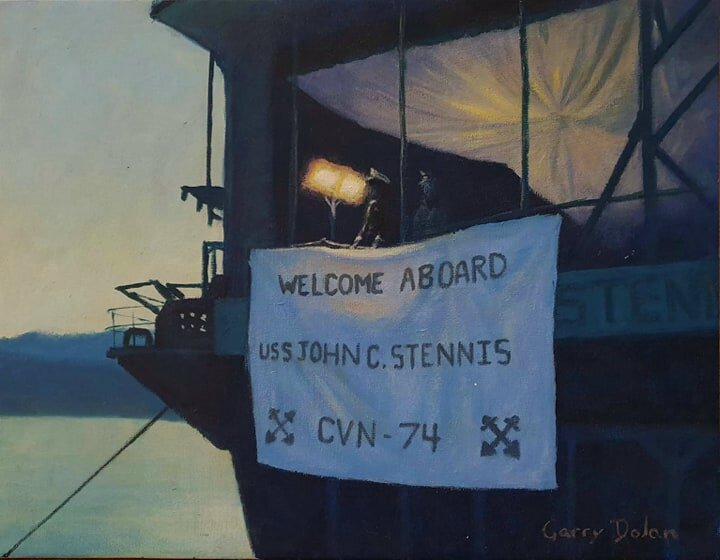
'Welcome aboard the Stennis' 30cm x 40cm Painted from personal experience of the friendship that exists between Australia and America. While living in Hobart, Tasmania, I enjoyed the opportunity to visit three United States Navy Aircraft Carriers, one being the USS John C Stennis. I snapped this photo after enjoying an afternoon of hospitality aboard this floating city. The City of Hobart warmly welcomed the American Navy on its ship’s regular visits and in turn the Navy warmly welcomed some of the lucky residents aboard. The visits highlighted to me on a personal level the close relationship the countries have as well as the closeness of our very similar and linked cultures.
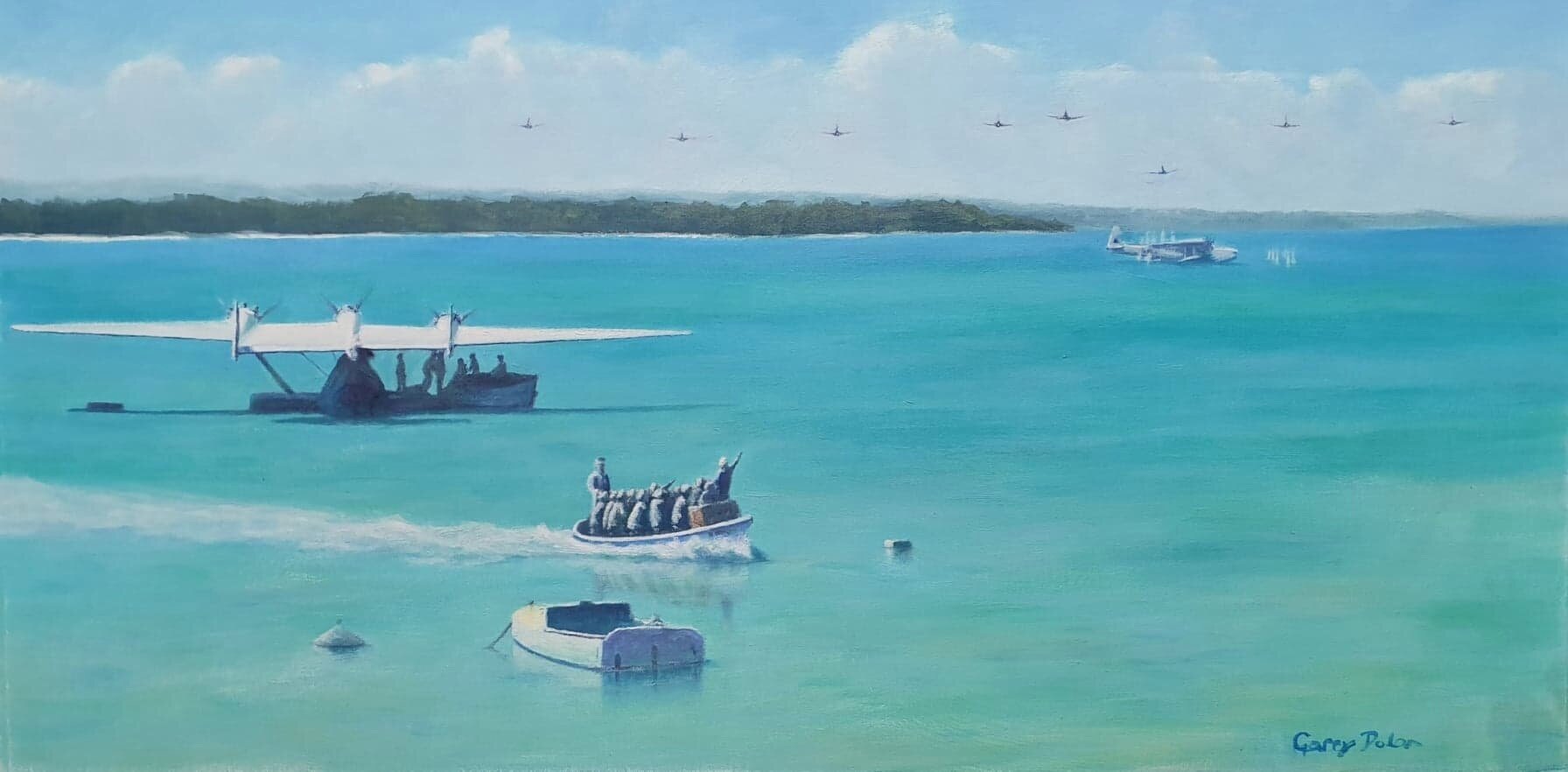
'Attack on Paradise', 90cm x 45cm Built on the pearling trade, these days Broome is a popular a beach resort town full of tourists from around the world and acts as the gateway to the wild Kimberley region of Western Australia Broome was of strategic value during WW2 and served as a refuelling point for aircraft on the route between the Netherlands East Indies and major Australian cities. As a result, Broome was on a line of flight for Dutch and other refugees, following the Japanese invasion of Java, and had become a significant Allied military base. During a two-week period in February–March 1942, more than a thousand refugees from the Dutch East Indies, many of them in flying boats passed through Broome On the morning of 3rd of March Zeros made strafing attacks on the flying boat anchorage at Roebuck Bay and the Royal Australian Air Force (RAAF) base at Broome Airfield with the loss of at least 88 people. The Japanese fighters destroyed at least 22 Allied aircraft. These included an airborne United States Army Air Forces B-24A Liberator loaded with wounded personnel it crashed in the sea off Broome with the loss of 30 servicemen. The Allies also lost 15 including eight PBY Catalinas, two Short Empires and five Dornier Do 24s; many Dutch refugees were on board. At the airfield, the Japanese fighters destroyed two B-17E Flying Fortresses and a B-24, two Lockheed Hudsons and a Lockheed Lodestar. A KLM Douglas DC-3 airliner was also shot down, 80 km north of Broome, with the loss of four lives and diamonds reportedly worth £150,000 – 300,000 (now approximately A$20–40 million). The Australian journalist, broadcaster and author Coralie Clarke Rees (1908–1972) published a highly personal account of the Broome air raid in her 1946 elegy to her dead airman brother, Silent His Wings You in a tiny hand-picked bunch of sappers chosen to gelignite Broome in the teeth of the down-swooping Jap, saw stately Dutch flying-boats, lovely Dutch women, riddled with bullets, blasted, floating, American Liberators and quaking Malays spine-shattered by the hail of yellow bombs. You smelt and tasted death and the tang of it never left your tongue.
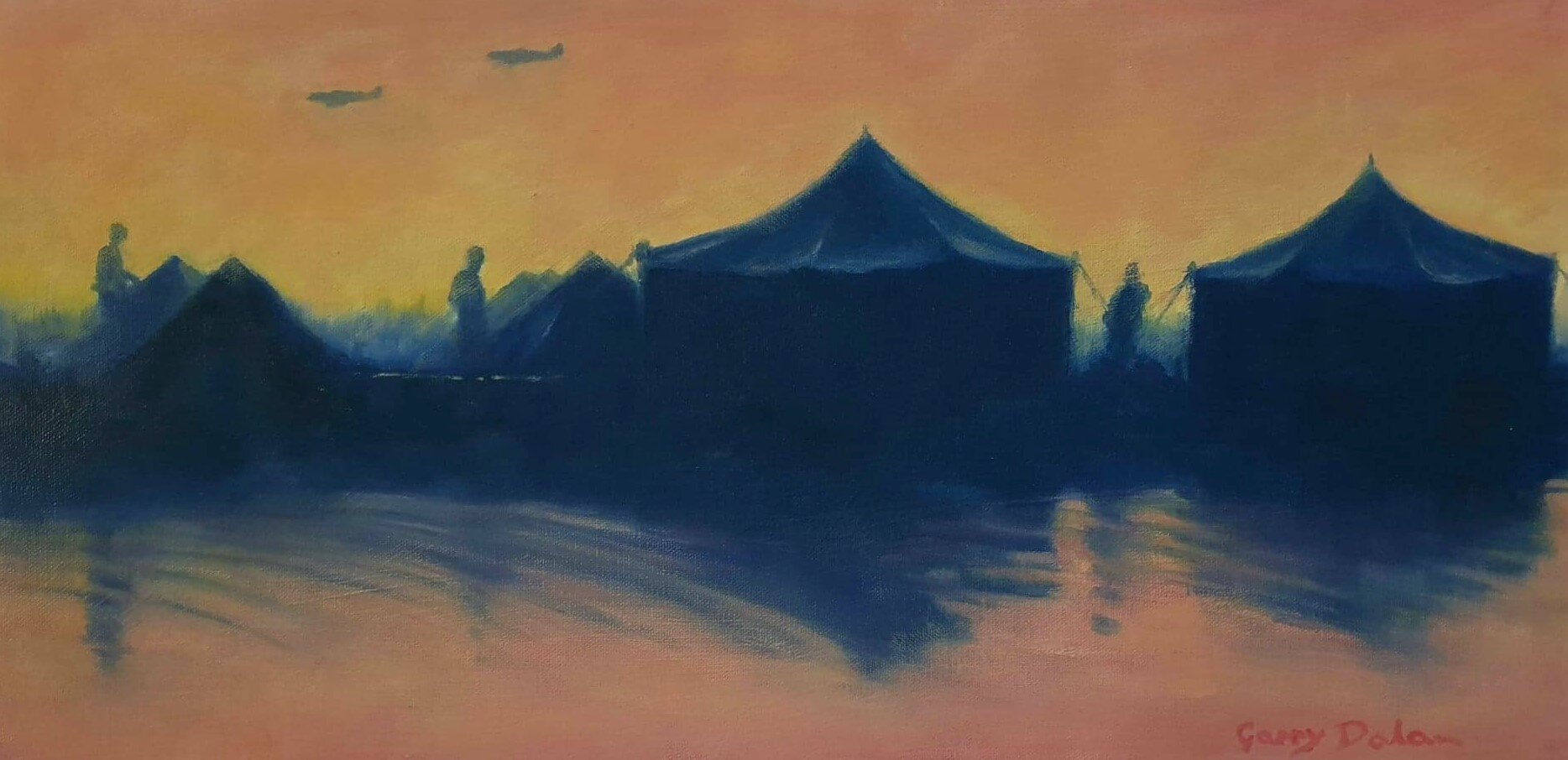
'Monsoon Sunset', 52cm x 26cm During WW2, Fenton Airfield, 200km south of Australia’s tropical northern Capital, Darwin, was a piece of America planted in the vast Northern Territory Outback. During 1943 and 1944 Fenton was the major offensive base for long range bombing operations against Japanese forces. With hundreds of American airmen and support units based at Fenton, in December 1943 Hollywood came to the Outback. A USO variety show starring John Wayne, Gary Cooper and other popular celebrities of the time performed under the stars to the delight of the hundreds of airman. The conditions for service personnel based in the Northern Territory was quite tough. Hot, dry and dusty for half of the year and hot and very wet during the other half with regular monsoonal storms deluging the camps. A letter from W.E. Pidgeon C/O of DPR Unit based at Fenton Airfield described the heat to his wife “I reckon must be the hottest blarsted spot in the whole N.T”.
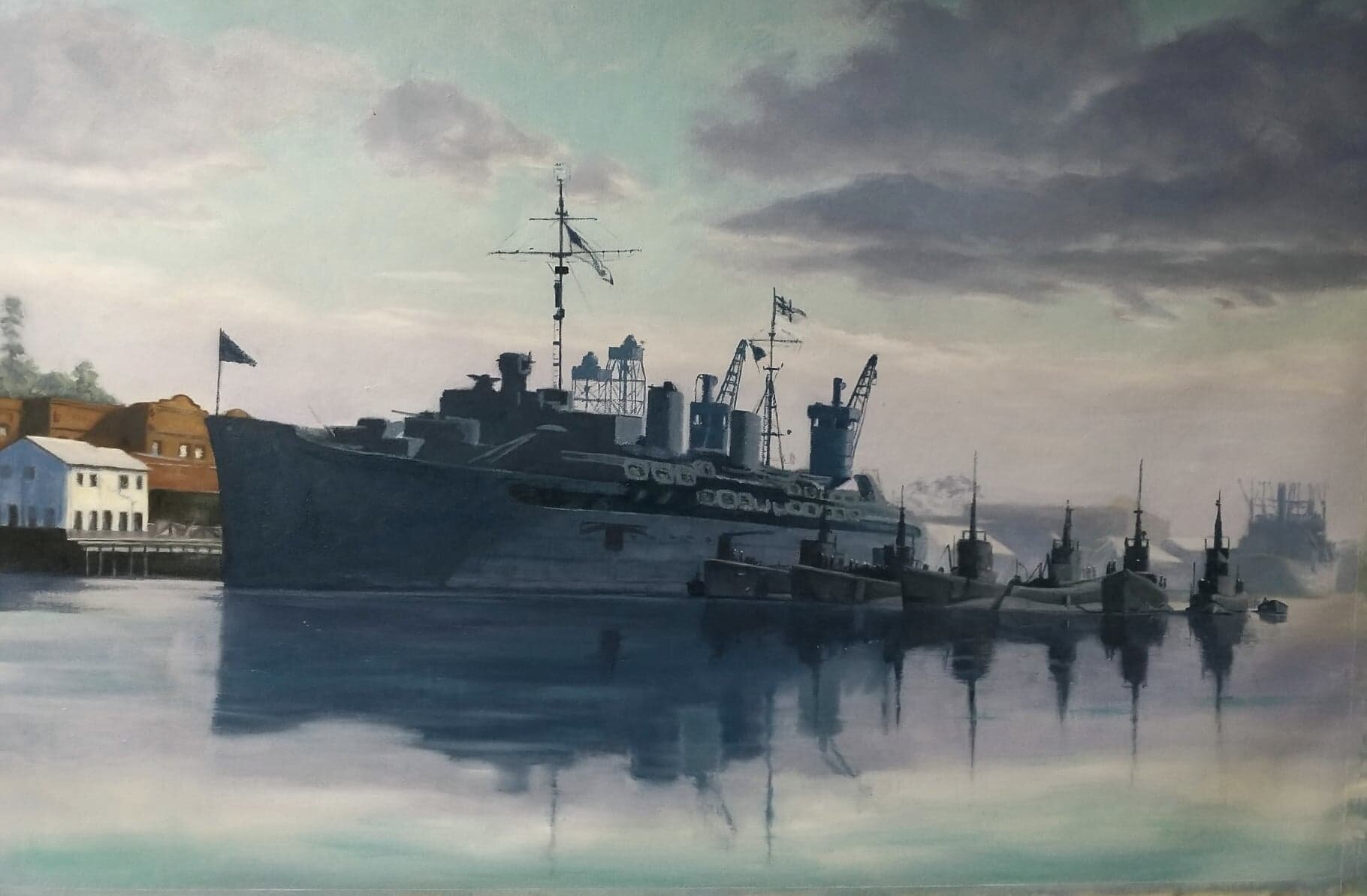
'A Safe Harbour', 90cm x 50cm The first Americans arrived in Brisbane on 22 December 1941, and by mid-1943 the number in Australia had risen to 150,000 with the largest concentrations in Queensland near Brisbane, Rockhampton, and Townsville including the Supreme Commander of South-West Pacific Area, General Douglas MacArthur. The social impact of the Americans was considerable with Australians influenced by American trends in fashion, manufactured goods, domestic technology, and consumerism. Cafés began advertising Coca-Cola, coffee, and hamburgers, hot-dog stands appeared, and American cinema influenced Australian fashion. By the end of 1944, two-thirds of Australia’s imports came from the United States. Capricorn Wharf at New Farm (Teneriffe) in Brisbane became a key submarine base. Bill Bentson, a staff sergeant on General Douglas MacArthur's staff remembers those days when up to 8 submarines could be seen at the wharf. Bill said "It was a busy place back then, the tram from New Farm to the city was always loaded with sailors." "There were hundreds stationed on the site - the barber shop around the corner did a roaring trade." "Next to the barber shop there was a restaurant and they used to go down and get some steak and eggs when they got tired of eating government issue food." Submarine Tender USS Fulton AS 11 arrived in Brisbane on 9 November 1942. USS Fulton established the Brisbane Submarine Base and rest camp at New Farm in Brisbane. USS Fulton was involved in refitting submarines between their war patrols and acted as a tender to other types of ships.
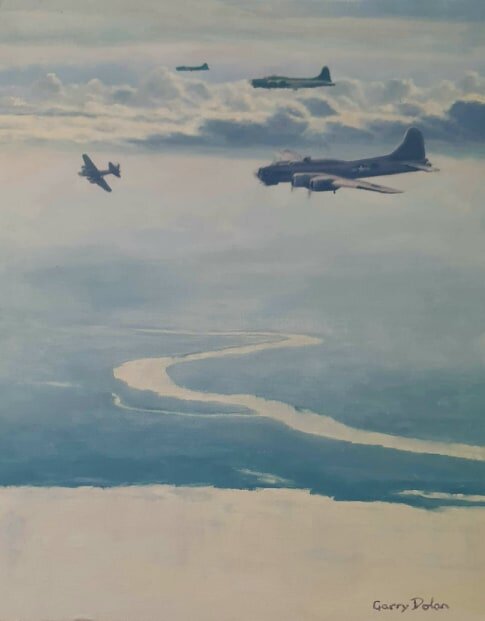
'The Kangaroo Squadron' 40cm x 50cm On 18 February 1942, the six B-17s of the ex-88th RS saw that weather reports for Townsville were bad and as they were only able to obtain an extra 800 gallons of fuel per B-17, Carmichael decided to fly to Brisbane that day rather than Townsville. They went on to become the first combat-ready American bomber squadron to arrive in Queensland, from where they mounted bombing raids on the Japanese. The painting depicts B-17s of the ex 88RS arrived at Archerfield Airfield on 18 February 1942. The 435th Bombardment Squadron, also known as the "Kangaroo" Squadron was formed in Australia in early 1942 by a combination of Fifth Air Force personnel and B-17 Flying Fortress aircraft that escaped from the Philippines and replacement aircraft that reached Australia from Hawaii and via the South Atlantic air ferry route from Florida, and arriving in Western Australia. As the 40th Reconnaissance Squadron, the squadron evacuated General Douglas MacArthur and President Manuel Quezon from Del Monte Field in the Philippine Islands in March 1942. The Fifth Air Force Headquarters was in the same building as General Douglas MacArthur in Brisbane, now a Museum.
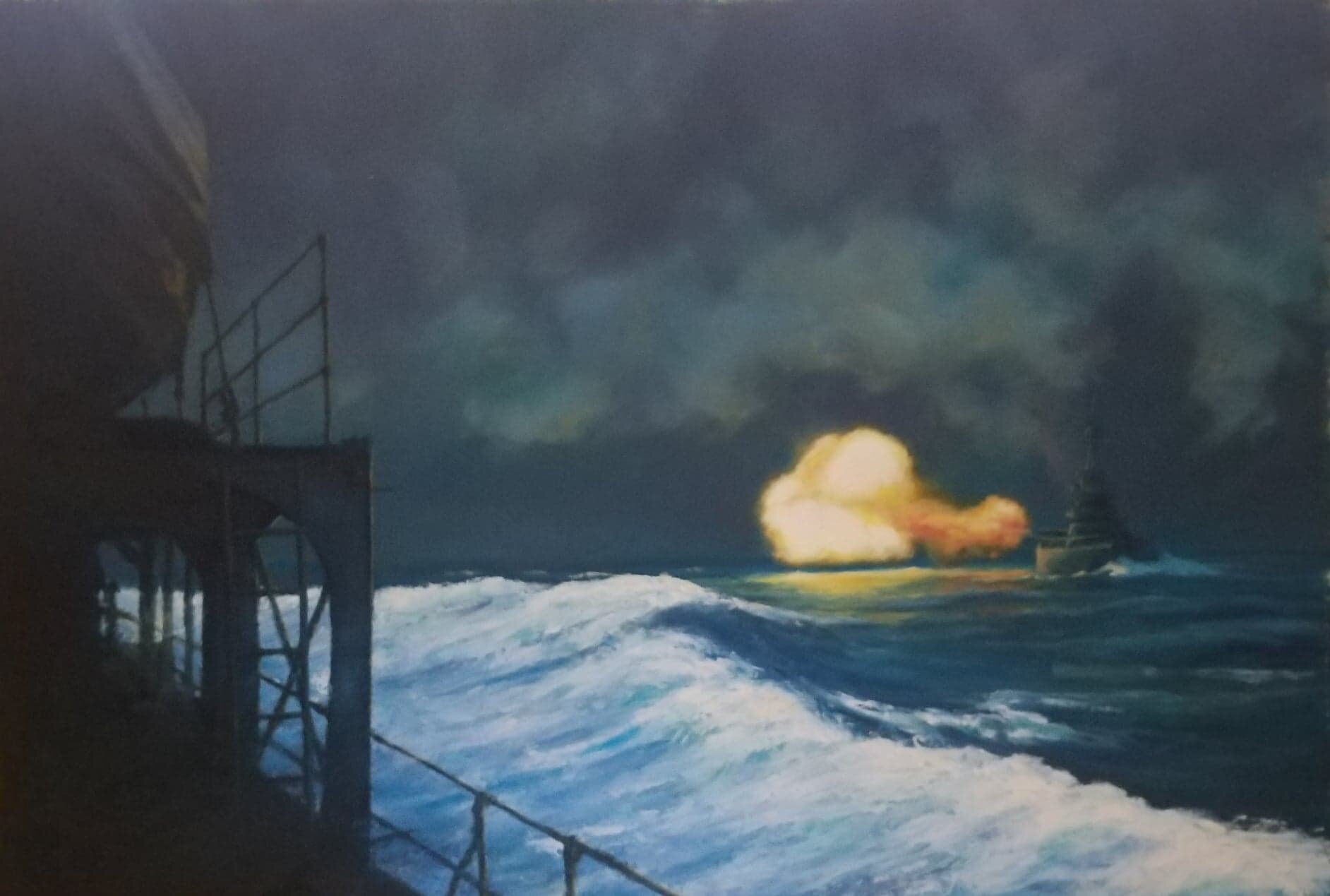
'Shoulder to shoulder' 84cm x 56cm In the early evening on 28 February, the USS Houston, HMAS Perth and the Dutch destroyer HNLMS Evertsen received orders to depart Tanjung Priok and head through Sunda Strait to Tjilatjap, on the south coast of Java on their way back to Australia to receive repairs after battle damage received in the Battle of the Java Sea The only ships they expected to encounter were Australian corvettes on patrol, in and around the strait itself. By chance, just after 22:00, a Japanese invasion convoy supported by a large Japanese flotilla of six cruisers, an aircraft carrier, numerous destroyers and a minelayer bound for West Java was entering Bantam Bay, near the north-west tip of Java. They sighting the Allied ships some time around 23:15. During a ferocious night action, the Allied cruisers were surrounded. Following severe damage from torpedo and shell impacts, Perth and Houston were abandoned after midnight and sank with the loss of 696 members of the crew of Houston and 375 from Perth, including the captains of both vessels. The Dutch destroyer Evertsen was run aground on a coastal reef to allow its crew to escape after a fire broke out. The survivors from the three Allied ships were taken prisoner and spent the next three and half years as POWs. This painting depicts the USS Houston returning fire as seen by crew aboard the HMAS Perth.
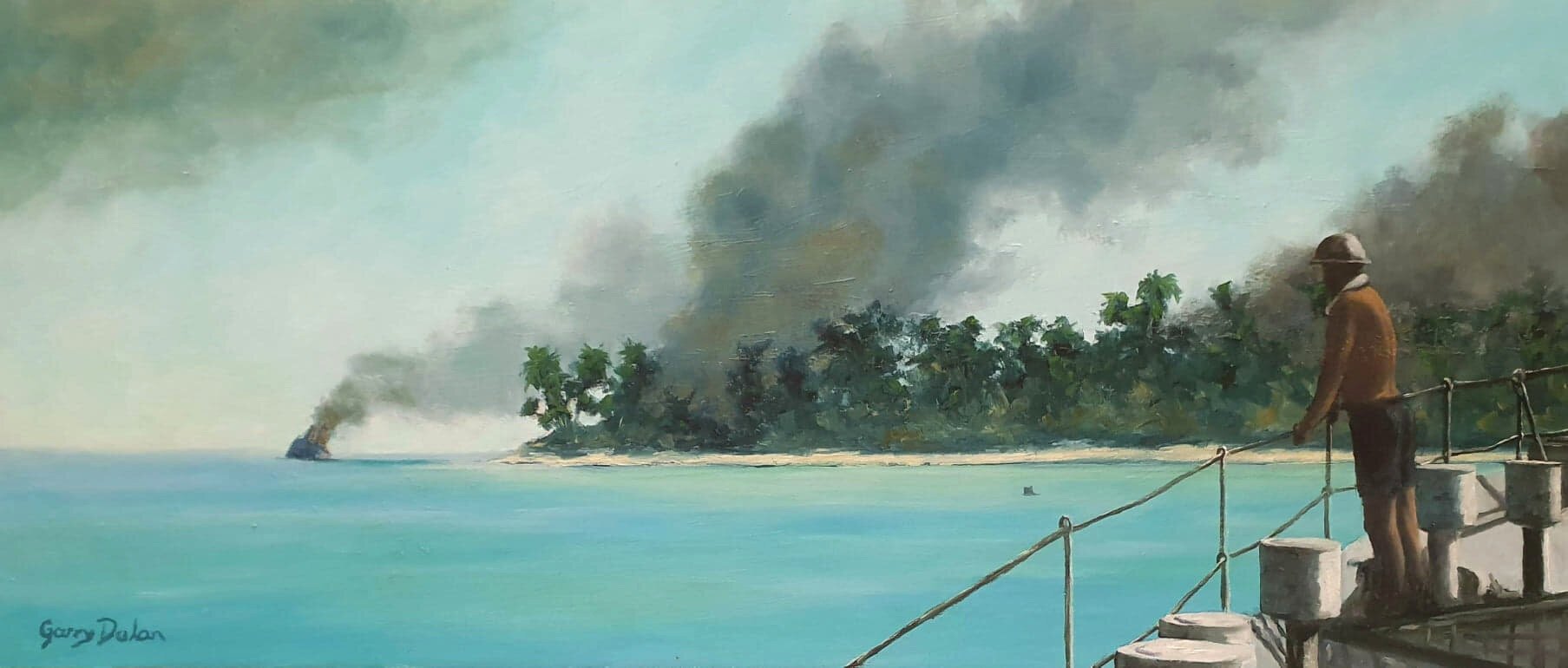
'Attack on paradise' 75cm x 32cm On 19 February 1942, Australia’s most northern major city Darwin was bombed. The first attack on Australian homeland saw Japanese fighters and bombers attack the port and shipping in the harbour twice during the day, killing 252 Allied service personnel and civilians including 144 American servicemen. The main target for the first attack was Darwin's harbour. There were upwards of 45 ships in the port, including the US destroyer Peary. Within minutes Peary had been sunk with a loss of 80 lives. Sunk also was the large US transport ship Meigs, the Australian ship Neptuna and five merchant ships. Formerly a passenger vessel Neptuna was loaded with heavy explosives and blew up with a terrifying explosion. The hospital ship Manunda was hit but survived to play an important role in caring for the injured. Historians say that the relationship between Australia and America was forged in fire on that day.